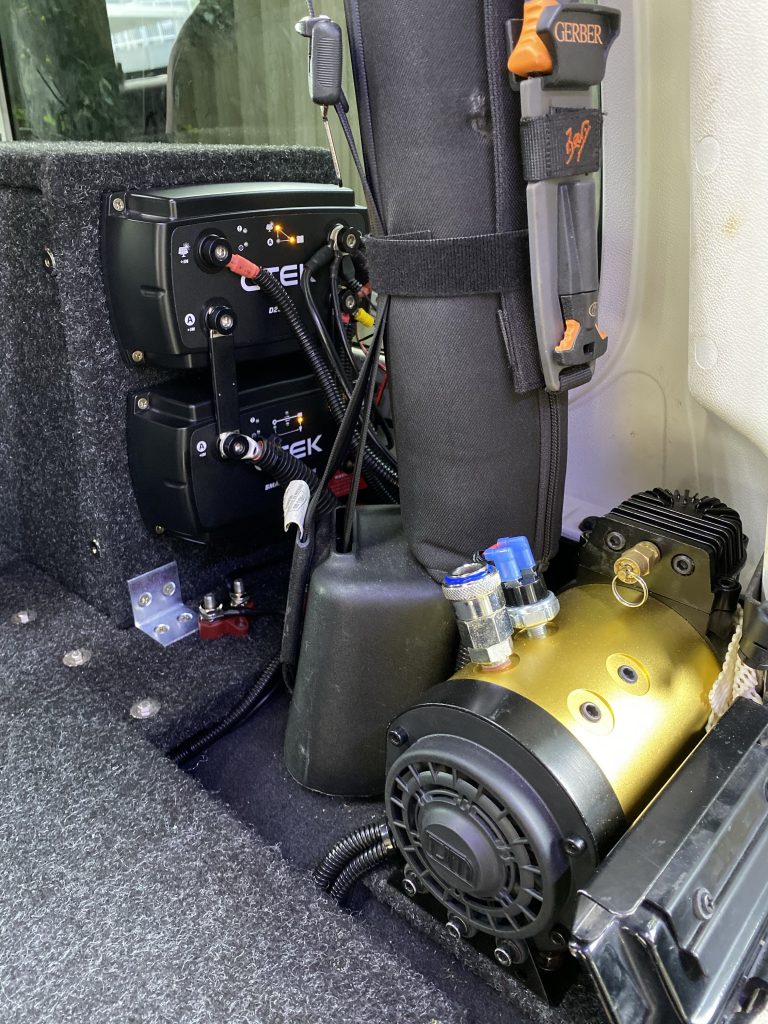When it comes to auxiliary battery solutions, we’ve had a few options in the TJ over the years.
We’ve always been fairly strong supporters of Redarc products and it makes total sense. They’re Australian made and stand up to the conditions of this arid and rugged land we call home.
We started with an SBI12 100 amp isolator before moving to a SBI212 200 amp unit when we added the winch. These did their job dutifully and without any fuss however it became clear quite quickly that, for our set up, these aren’t the ideal option.
While they fulfil the requirement of charging the auxiliary battery and allowing batteries to be linked for winching and emergency starting, the later of which was indeed required on a couple of occasions, subjecting AGMs batteries to the full amp output of the alternator turned out to be less than desirable.
This played out in spectacular fashion when we were on our way back from Cape York in 2013. We were literally 5 minutes from home after an epic 6 week journey when the auxiliary battery blew the emergency vent and subsequently pumped the cabin full of rotten egg smelling gas.
Anyone with a TJ will know there is a lack of room under the bonnet for a decent sized second battery so the best option is to store it in a battery box in the cabin, hence the cabin full of gas.
This situation is caused by overcharging and a build of gas to the point where it had to vent.
When taking the battery out of the box it was completely deformed, with the sides all bulging out. It was indeed, toast.
After this event, compromises need to be considered. One thing we’ve learned over the years is that compromise is a fact of life, especially when you are, for some unknown reason, inexplicably dedicated to touring in a TJ Wrangler.
The compromise in this case was to move away from the ability to link starting and auxiliary batteries and to move to a DC-DC charging solution to ensure we don’t have a repeat of battery-gate.
The end result was to purchase a Redarc BCDC1240 DC-DC charger, along with a replacement AGM battery (this was 2013 after all and lithium was still learning how to walk).
The DC-DC charger worked wonders. Not only did it provide a nice charging profile, tuned for AGM battery health, it provided the option of a solar input, which opened doors in other ways.
The compromise of not being able to link the batteries together could be managed by a set of jumper leads, which we carry around anyway, so all was good in the world.
Or was it…
The BCDC, like all Redarc products we’ve used in the past, did it’s job perfectly. The only issue was, due to it being an early model, it didn’t auto switch between alternator and solar input. However, with a correctly wired two way relay, a simple switch could be employed to switch between inputs.
This solution saw us achieve a solid 6 years out of the replacement AGM battery, right up until recently when it wasn’t quite keeping up and needed replacement. Enter Lithium.
Lithium battery technology had evolved over the preceding 6 years and in 2020 was ripe for consideration as the AGM started to let go. With this in mind, and knowing that the old BCDC didn’t have a lithium profile, research began into what Redarc product would fit the bill.
The obvious choice was the now revamped BCDC charger, with added lithium profile and auto switching between solar and alternator. Sorted.
Or maybe not…
One thing that was always at the back of mind was that, with a DC-DC charger, the rate of charge is lower than a battery directly connected to the alternator. While this saves the battery from overcharging, it means you have to run the alternator longer to get a full charge.
Often we’ll be stationary for a couple of days, and if the sun isn’t playing the game, the solar isn’t enough to keep up with the fridge. To counteract this we run the TJ for a while. To top up the auxiliary battery, even at 40amps will take a couple of hours. And when you’re in the middle of nowhere, with a TJ guzzling unleaded at a rate of knots, it’s not an ideal situation.
So what’s the best option with the following requirements:
- Rapid charging of auxiliary battery (more than 50 amps)
- Protection from over-charging
- Automatic solar or alternator charging
- Lithium charging profile
- Emergency starting from auxiliary (bonus)
There isn’t a Redarc product that can satisfy these needs without adding in manual isolation switches etc.
Thankfully there is a solution, but it’s not from Redarc. It comes by way of the combination of the CTEK D250SE linked to the CTEK Smartpass 120S.

This combination of products, while costing just slightly more than a BCDC1250D, comes with the following benefits:
- Up to 140 amps of charging from the alternator and the solar input.
- Lithium profile with smart charging handled by the D250SE and bulk charging from the Smartpass 120S
- Automatic linking to the starting battery if the Smartpass detects that the starting battery needs help – Bonus achieved.
- Added Bonus – Trickle charging of the starting battery if the auxiliary battery is full. We love this as our TJ can often sit for long periods without being driven and if the solar panel is in the sun, then it keeps both batteries in top condition
As always there are compromises with this approach, the main one being a slower 20 amp solar charging rate which could be much higher with a BCDC1250D for example. We can live with this knowing that a quick run of the engine will top the auxiliary battery up when required.
So what about reliability you say? Well that remains to be seen. With the installation just completed only time will tell if the CTEK approach holds up to the same level that the Redarc products do.
We certainly hope they do, and as they are housed in the cabin along with the 100Ah Lithium battery, there is a fair chance they’ll be content to do their individual and combined jobs for many years to come.

